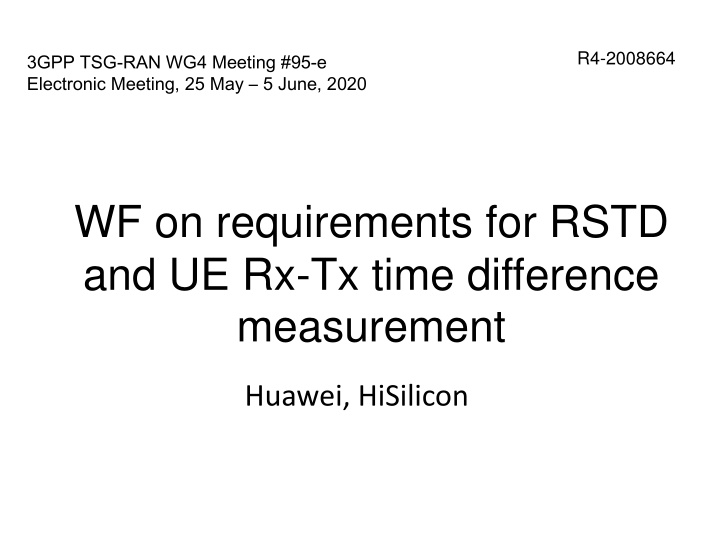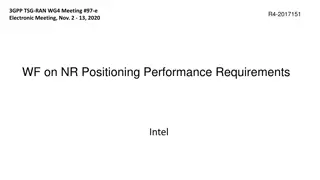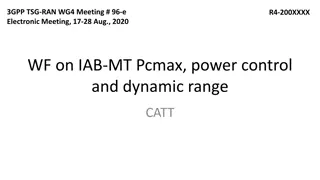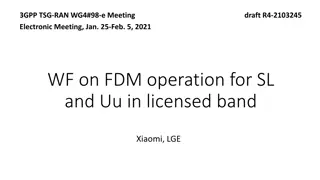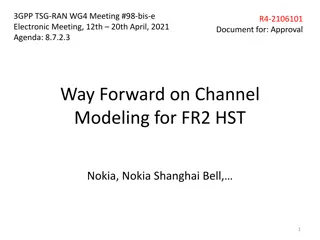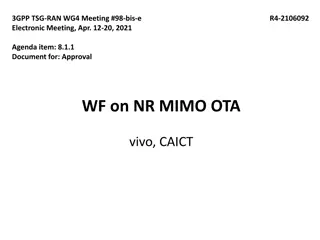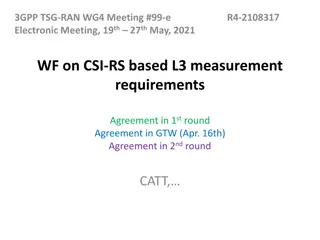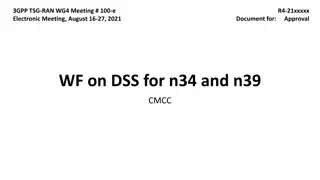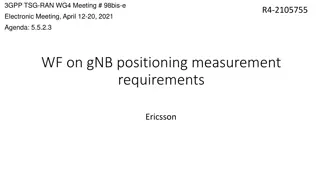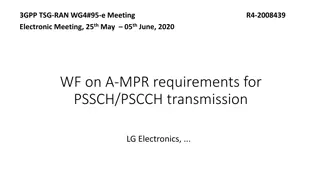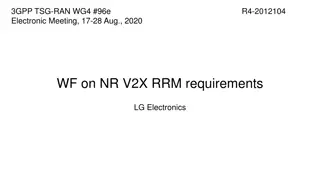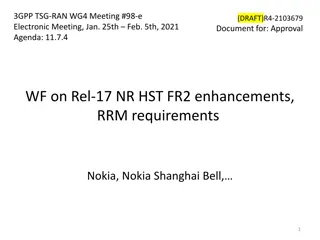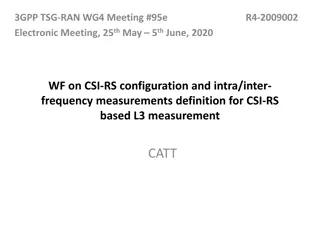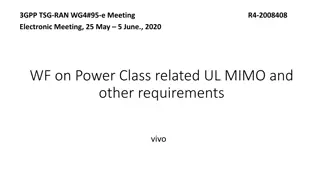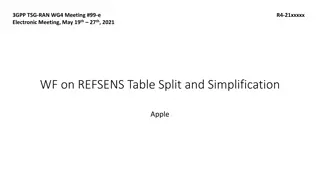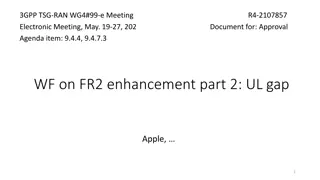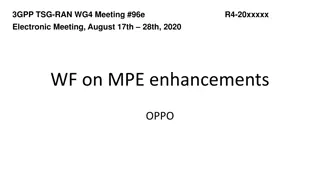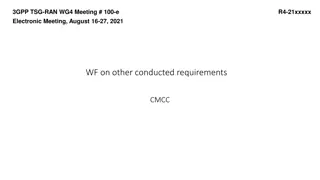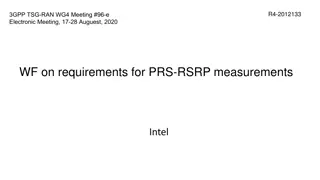Definition and Measurement Periods for RSTD in 3GPP TSG-RAN WG4 Meeting
In this document from the 3GPP TSG-RAN WG4 Meeting, the definition of intra/inter-frequency measurements, scenarios for RAN4 requirements, and measurement periods for RSTD are discussed. The focus is on requirements for RSTD and UE Rx-Tx time difference measurements. Various options and factors are considered, such as PRS occasions, periodicity of PRS measurements, and sampling and processing times.
Download Presentation

Please find below an Image/Link to download the presentation.
The content on the website is provided AS IS for your information and personal use only. It may not be sold, licensed, or shared on other websites without obtaining consent from the author.If you encounter any issues during the download, it is possible that the publisher has removed the file from their server.
You are allowed to download the files provided on this website for personal or commercial use, subject to the condition that they are used lawfully. All files are the property of their respective owners.
The content on the website is provided AS IS for your information and personal use only. It may not be sold, licensed, or shared on other websites without obtaining consent from the author.
E N D
Presentation Transcript
R4-2008664 3GPP TSG-RAN WG4 Meeting #95-e Electronic Meeting, 25 May 5 June, 2020 WF on requirements for RSTD and UE Rx-Tx time difference measurement Huawei, HiSilicon
Definition of intra/inter-frequency measurement Do not define intra/inter-frequency definition for PRS-RSTD Note: Accuracy may be different depending whether the measurements are done on the same positioning frequency layer or not. Do not define intra/inter-frequency definition for PRS-RSRP Note: Classification of accuracy requirements is FFS (e.g. whether to define different accuracy for measurements on different frequencies) Do not define intra/inter-frequency definition for UE Rx-Tx timing difference Note: Classification of accuracy requirements is FFS (e.g. whether to define different accuracy for measurements on different frequencies)
Scenarios for the requirements RAN4 requirements are to be defined only for the case where PRS is measured with configured measurement gap This applies for RSTD, PRS-RSRP and UE Rx-Tx time difference For UE Rx-Tx time difference, RAN4 requirements are to be defined at least for the case where the positioning SRS resource is on the same band as PRS frequency layer FFS: if requirements are to be defined for the case where the positioning SRS resource is in a different band from PRS frequency layer
Measurement period for RSTD (1) PRS occasion definition: Option 1: PRS occasion is the time duration spanned by one DL PRS resource after repetition by DL-PRS-ResourceRepetitionFactor its corresponding DL- PRS-expectedRSTD-uncertainty. Option 2: PRS occasion is one single DL PRS repetition (i.e. repetition factor of 1) Option 3: PRS occasion is one comb pattern without being repeated within a slot and without applying a resource repetition factor (Ericsson) Basic number of PRS occasions Option 1. A certain number (X) of PRS occasions, X=4 Option 2. ceil(NPRS,req/ KPRS) NPRS,reqis the comb pattern realizations that are required for RSTD measurement, derived from simulation results KPRS= LPRS/CombSizeN ResourceRepetitionFactor is the number of comb pattern realizations within a single TPRS, LPRSis the number of PRS symbols per slot
Measurement period for RSTD (2) FFS: Periodicity of PRS measurement Option 1. max T,TPRS,MGRP Option 2. max TPRS,MGRP other options not precluded Companies are encouraged to check on all possible values for T, Tprs and MGRP FFS: Sampling and processing time Option 1: T Option 2.NPRS=N other options not precluded TTPRS
Measurement period for RSTD (3) FFS: Scaling of PRS occasions due to UE processing capability slot NPRS N LPRS N Option 1. { max , } Option 2. Depends on T and Tprs slot NPRS N slot N slot LPRS N , if Tprs <= T NPRS LPRS N T , of Tprs > T Tprs NPRS N Option 3. other options not precluded FFS: requirements do not apply for resources spanning over two sampling periods of N FFS: requirements apply provided that the configured PRS duration K is no larger than N FFS: Calculation of PRS occasion duration Option 1. RAN4 to define RSTD measurement period based on Type 2 PRS duration calculation. RSTD measurement period for Type 1 PRS duration calculation shall be no longer than Type 2. Option 2. measurement period requirements are defined based the type (type 1 or type 2) as UE used to report {N,T} other options not precluded
Measurement period for RSTD (4) For FR1, no impact of UE RX beam sweeping on RSTD measurement period shall be considered For FR2 Use Rx beam sweeping factor similar way as in SSB-based RRM (i.e. no intra-PRS-occasion Rx beam sweeping) for the case when the QCL information is not available to the UE FFS how to handle the case when the QCL information is available to the UE Option 1: Do not perform RX beam sweeping Option 2: Perform RX beam sweeping Solutions with more advanced RX beam sweeping can be considered in the future releases
Measurement period for RSTD (5) FFS Measurement period with multiple PRS periodicities Option 1. Use the maximum PRS resource periodicity among all PRS resources Option 2. LMF needs not to provide multiple PRS periodicity to UE with a single layer at least other options not precluded FFS Measurement period with multiple PRS frequency layers Option 1. Measurement periods adds up for each frequency layer that is configured to be measured Option 2. Measurement period is scaled by number of frequency layers Option 3. Based on CSSF
Measurement period for RSTD (6) Extension of measurement period due to HO TRSTD FDD, NR,HO= TRSTD FDD, NR+k TPRS+THO k is the number of times the handover occurs during TRSTD FDD, NR,HO ???is the time during which the RSTD measurement may not be possible due to handover. FFS Whether PRS occasion dropping due to SSB collision should be accounted in measurement period Option 1. Yes Option 2. No, measurement period will be defined for cases when PRS occasions are not dropped for any reason FFS Measurement period exceeding responseTime Option 1. Extension of positioning measurement period due to HO shall not exceed responseTime. UE behaviour in such case is FFS. Option 2. No RAN4 impact Option 3. Measurement period requirements on measurement period is independent of responseTime ms
Measurement period for UE Rx-Tx time difference (1) FFS: Whether SRS periodicity should be accounted in Rx-Tx time difference measurement period FFS: Whether SRS dropping should be accounted in measurement period FFS: Measurement period with HO Option 1. When the UE Rx-Tx time difference measurement period is extended, the extension depends on the number of serving cell changes and on the corresponding interruption time Option 2. UE should re-start the Rx-Tx time difference measurement after cell change FFS: whether UE shall continue the UE Rx-Tx time difference measurement during which timing adjustment for its UL transmissions, autonomous adjustment or based on configured TA, occurred one or more times FFS: for UE autonomous adjustment and for network issued TA change Consider the issue together with gNB Rx-Tx time difference measurement behavior
Measurement period for UE Rx-Tx time difference (2) FFS: Proximity between SRS and PRS Option 1. The measurement requirements for UE Rx-Tx timing difference is applicable only if the configured parameters SRS-Slot-offset and SRS- Periodicity for SRS resource for positioning are such that any SRS transmission is within [-25, 25] msec of at least one DL PRS resource of each of the TRPs in the assistance data Option 2. Rx-Tx timing difference measurement period requirements apply provided that there is at least one SRS transmission within the measurement period. Option 3. The requirements for UE Rx-Tx apply regardless of the time separation between SRS and PRS. If the closest subframes #i and #j are separated by more than subframe, the UE shall compensate for the difference in the received timing of radio frame #i used for TUE-TX estimation and the subframe #j. Other options not precluded
Measurement capability FFS: RAN4 not define measurement capability requirements for PRS measurement FFS: Requirements when PRS configuration in assistance data exceeds reported capabilities FFS: If the time span of a DL PRS resource instance (i.e., the time duration spanned after repetition by DL-PRS- ResourceRepetitionFactor) its corresponding DL-PRS- expectedRSTD-uncertainty is greater than ?, where ? is the duration of DL PRS symbols in ms that UE is capable of processing, measurement requirements do not apply.
Reporting criteria RSTD reporting criteria: Ecat = 1, one report for RSTD per positioning session, which includes RSTD measurements and PRS-RSRP measurements (if configured with RSTD and supported by UE). UE Rx-Tx reporting criteria: Ecat = 1, one report for UE Rx-Tx time difference per positioning session, which includes UE Rx- Tx time difference measurements and PRS-RSRP measurements (if configured with UE Rx-Tx time difference and supported by UE).
Side condition FFS: Side condition for RSTD measurement in FR2 Option 1. PRS SNR of reference cell to be -3 dB and the side condition for PRS SNR of neighbor cells to be -10 dB. Option 2. Side conditions for PRS RSTD measurements in FR2 are defined same as those in FR1, i.e. -13dB for neighbour cell and -6dB for serving cell.
Measurement accuracy (1) FFS: Number of samples for RSTD accuracy: 1 1 sample includes resource repetitions within the PRS occasion FFS: Number of samples for UE Rx-Tx time difference accuracy: 1 1 sample includes resource repetitions within the PRS occasion FFS: Whether RSTD and UE Rx-Tx accuracy is agnostic to comb Companies are encouraged to study the impact of number of symbols within a slot Applicable RSTD accuracy requirement is not impacted by HO FFS: Assumption on antenna panel in defining accuracy requirements
Measurement accuracy (2) FFS: Serving vs. neighbour for Rx-Tx time difference accuracy Option 1. Only one set of accuracy requirements applicable to both serving and neighbor cells to be defined. Option 2. Specify UE Rx-Tx time difference accuracy requirements for serving cell and for neighbor cell separately UE Rx-Tx time difference accuracy requirements do not apply underwith TA change during the measurement period UE Rx-Tx time difference accuracy requirements do not apply underwith NTA_offsetchange during the measurement period FFS: whether this needs to be captured in the specification FFS: UE Rx-Tx time difference accuracy requirements do not apply with HO during the measurement period
Report mapping (1) Relation between k1 and k2 1 (BWPRS,i) Option 1. k1 k2 log2 4Tcmin i i is the positioning layer frequency layer index of all RSTD measurements of the same TRP pair. Option 2. k2 >= k1 Option 3. RAN4 not to define relationship between k1 and k2 Option 4. k2 <= k1 Option 5. UE shall report based on the finest granularity it can achieve Applicable values for k in FR1 Option 1. {1,2,3,4,5} Option 2. {2,3,4,5} Option 3. {0,1,2,3,4,5} Option 4. {3,4,5}
Report mapping (2) Report mapping for differential RSTD and Rx-Tx time difference Option 1. Allow different ranges for different k values Option 2. Ensure the same range for all k s, e.g., by increasing the last reporting interval to 8192 for all k values Report mapping for additional path Option 1. Allow different ranges for different k values Option 2. Ensure the same range for all k s, e.g., by increasing the last reporting interval to +/- 8175 for all k values
MG and Scheduling restriction FFS: It is up to UE implementation to request measurement gaps for PRS measurement. FFS: If UE requested measurement gaps for PRS measurement but the gaps are not configured, UE is not expected to measure PRS FFS: If UE did not request measurement gaps for PRS measurement, UE is expected to process DL PRS in the same OFDM symbol where other DL signals and channels are transmitted to the UE
